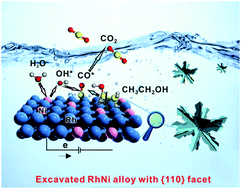我室周志有教授和谢兆雄教授在 Journal of Materials Chemistry A 上发表论文:Excavated RhNi alloy nanobranches enable superior CO-tolerance and CO2 selectivity at low potentials toward ethanol electro-oxidation
文章链接:https://pubs.rsc.org/en/content/articlelanding/2019/ta/c9ta10327a#!divAbstract
摘要:
Electrocatalysts during ethanol oxidation still suffer from poor CO2 selectivity and are easily poisoned by CO intermediates at low overpotentials, causing great challenges for commercial viability of direct ethanol fuel cells. Herein, we report the synthesis of excavated RhNi alloy nanobranches constructed from ultrathin nanosheets with high-energy {110} facets and a large specific surface area (50.0 m2 g−1). These unique RhNi nanobranches achieve a CO2 selectivity of as high as 16.0% toward the EOR in alkaline solution, far exceeding the reported value of most Pd, Pt or Rh-based electrocatalysts in alkaline solution to date. More strikingly, the excavated RhNi nanobranches show outstanding CO-poisoning tolerance ability, resulting in a high CO2 selectivity at low potentials. Both CO stripping and in situ FTIR spectra of the EOR and CO oxidation analyses reveal that the alloying of Ni into Rh endows the nanobranches with high CO anti-poisoning ability, and thus great CO2 selectivity at low potentials.
